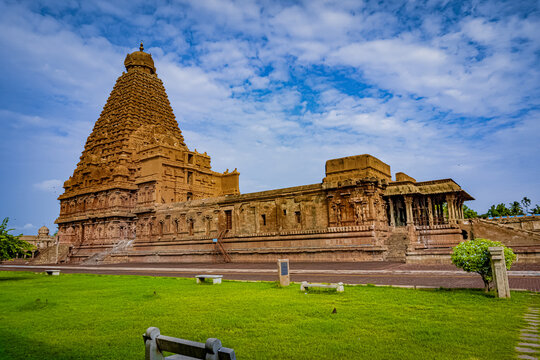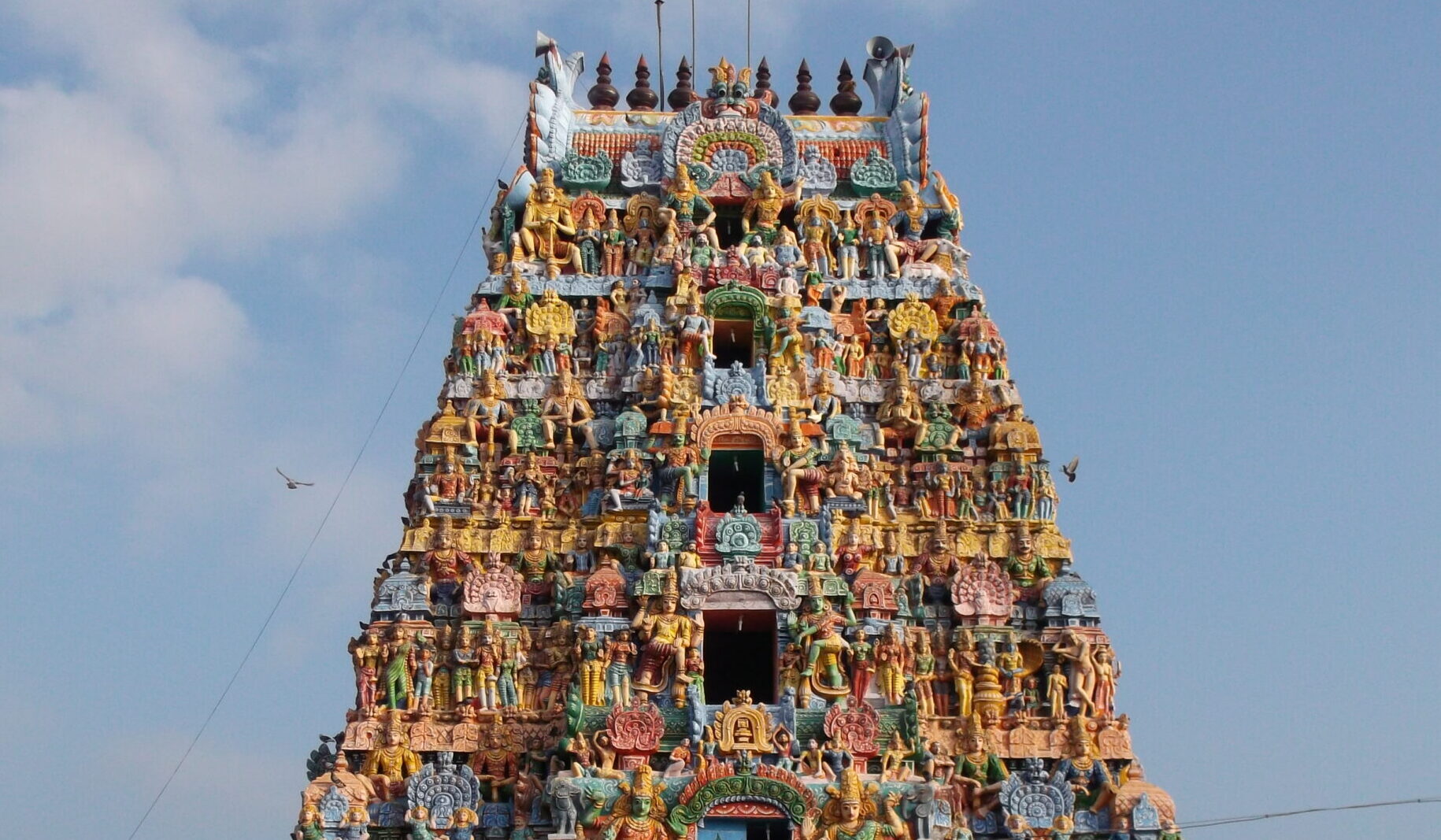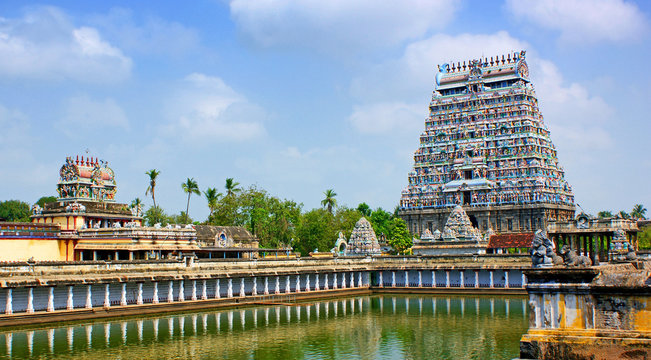¤ 20 minutes Read
Places to visit in Thanjavur
The cultural capital of Tamil Nadu, is a city where history, art, and devotion come alive. Famous for the UNESCO-listed Brihadeeswarar Temple, the city also boasts royal palaces, ancient libraries, and vibrant markets. From exquisite bronze sculptures to classical music and dance, every corner of Thanjavur reflects its glorious past and artistic excellence. A visit here offers a perfect blend of spirituality, architecture, and tradition.
Wiki Link: Places to visit in Thanjavur

Brihadeeswarar Temple
Also called the Big Temple, is a UNESCO World Heritage Site and the crown jewel of Thanjavur. Built by Raja Raja Chola I in the 11th century, it is one of the finest examples of Dravidian temple architecture. The temple is dedicated to Lord Shiva and features a 66-meter-tall vimana (tower) that dominates the skyline.
The massive granite Nandi statue and the intricately carved frescoes are major highlights. The temple’s sheer scale and precision in construction leave visitors awestruck.

Punnainallur Mariamman Temple
A revered temple dedicated to Goddess Mariamman, it is known for its vibrant festivals and atmosphere. Devotees flock here for blessings of health.

Thanjavur Royal Museum
Located within the palace complex, the museum exhibits royal costumes, weapons, and rare artifacts. It provides insights into the Maratha and Nayak legacy.

Bell Tower (Watch Tower)
This towering structure was once used for royal announcements. Climbing to the top offers panoramic views of the palace and the city beyond.

Sangeetha Mahal
A hall with remarkable acoustics, it was used for royal musical performances. The architecture reflects the city’s love for classical music and art.

Thanjavur Maratha Palace
Also known as the Nayak Palace, is an architectural and historical landmark built in the 16th century. Initially constructed by the Nayaks and later expanded by the Marathas, it showcases a unique blend of styles. The palace houses a grand Durbar Hall with ornate arches and murals that narrate stories of past rulers.
Visitors can also explore secret tunnels, courtyards, and watchtowers within the complex. Though partially in ruins, the palace exudes old-world charm and grandeur.

Keelaperumpallam Temple
Dedicated to Ketu, this temple is part of the Navagraha circuit. Pilgrims visit to seek relief from astrological afflictions.

Alangudi Guru Temple
Dedicated to Guru (Jupiter), this temple is an important pilgrimage site. Devotees come to seek wisdom, prosperity, and relief from planetary doshas.

Manora Fort Tower
Built by Serfoji II to commemorate the victory of the British over Napoleon, this 8-story tower overlooks the Bay of Bengal.

Karanthai Temple
A lesser-known temple in Thanjavur, it is admired for its peaceful surroundings and Dravidian architecture.

Saraswathi Mahal Library
Housed within the Thanjavur Palace complex, the Saraswathi Mahal Library is one of the oldest and most remarkable libraries in Asia. Established during the Nayak and Maratha periods, it preserves over 49,000 manuscripts written on palm leaves and paper in various languages like Sanskrit, Tamil, Telugu, and Marathi.
The collection includes rare medical texts, historical records, and literary masterpieces. The library also features ancient maps, paintings, and scientific works. Scholars and history lovers find it a treasure trove of knowledge.

Schwartz Church
Built in 1779 by Raja Serfoji II, this church honors Danish missionary Reverend Schwartz. Its simple yet elegant architecture reflects Thanjavur’s cultural diversity.

Sivaganga Park
A family-friendly attraction near the palace, the park offers lush gardens, boating facilities, and a mini-zoo. It’s an ideal spot for relaxation and leisure.

Rajaraja Chola Art Gallery
Named after the great Chola king, this gallery houses a stunning collection of bronze sculptures, stone carvings, and ancient artifacts from the Chola dynasty.

Art Gallery at Thanjavur Palace
Located inside the palace, the Art Gallery houses a fascinating collection of Chola, Nayak, and Maratha period bronzes and stone sculptures. The most striking exhibits are the exquisite Chola bronze idols, known for their fine detailing and lifelike beauty.
The gallery also displays ancient weaponry, carved pillars, and traditional paintings. It offers a glimpse into the flourishing artistic traditions of Tamil Nadu. Visitors can trace the evolution of South Indian art through the carefully preserved pieces. The gallery is a must-visit for art lovers and cultural enthusiasts.

Gangaikonda Cholapuram
Another UNESCO World Heritage site, was built by Rajendra Chola I in the 11th century to celebrate his victorious northern campaigns. The temple rivals Brihadeeswarar Temple in its magnificence, with a slightly shorter yet more intricately designed vimana.
Its detailed sculptures and carvings exhibit refined craftsmanship. The temple complex is surrounded by lush greenery, adding to its serene charm. The massive lion well and beautifully carved mandapas are key highlights. It reflects the zenith of Chola power and artistry.

Velankanni
Popularly called the “Lourdes of the East,” this church is a major Christian pilgrimage site. The annual festival attracts thousands of devotees.

Trichy
Famous for the Rockfort Temple perched on a massive rock, also boasts the Srirangam Temple. It blends history, architecture, and spirituality.

Poompuhar
An ancient Chola port city, Poompuhar is rich in history and legend. It is mentioned in Sangam literature and known for its beach and sculptures.

Thiruvaiyaru
Renowned as the home of Saint Tyagaraja, this town hosts the annual Thyagaraja Aradhana music festival, a must-visit for Carnatic music lovers.

Airavatesvara Temple, Darasuram
Located near Kumbakonam, is another jewel of the Chola dynasty and part of the “Great Living Chola Temples” UNESCO group. Built in the 12th century by Rajaraja Chola II, the temple is dedicated to Lord Shiva. It is famed for its intricate stone carvings and architectural brilliance, particularly the ornate pillars and exquisite sculptures.
The temple’s mandapas are adorned with scenes from mythology and everyday life. Its compact yet artistic design showcases the peak of Chola artistry.

Kumbakonam
Known as the “Temple Town,” Kumbakonam is filled with ancient shrines, including the Sarangapani and Adi Kumbeswarar temples. It’s also famous for its degree coffee.

Chidambaram
Home to the iconic Nataraja Temple, Chidambaram is a spiritual center celebrating dance and devotion. The annual Natyanjali festival attracts artists from across the globe.

Nagore Dargah
A revered Sufi shrine, Nagore Dargah draws visitors of all faiths. Its stunning Indo-Islamic architecture and vibrant festivals make it a significant pilgrimage site.

Swamimalai
One of the six abodes of Lord Murugan, is a revered pilgrimage center located near Kumbakonam. The temple sits atop a small artificial hill with a flight of 60 steps, symbolizing the Tamil alphabet. It is believed that Lord Murugan here imparted the meaning of the Pranava Mantra “Om” to his father, Lord Shiva, making it a spiritually significant site.
The temple’s striking gopuram and sanctum display traditional Dravidian architecture. Pilgrims flock here to seek blessings and spiritual growth. The vibrant atmosphere, combined with devotion and culture, makes it a must-visit near Thanjavur.
Thanjavur Blogs
- Tamil Nadu Cultural guide
- Places to visit in Thanjavur
- Places to visit nearby Thanjavur
- India’s most popular destination
- India’s archaeological marvels
Recommended articles
- Uttar Pradesh Cultural guide
- Places to visit in Varanasi
- Places to visit nearby Varanasi
- India’s most popular destination

